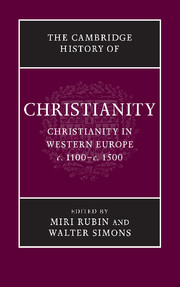Book contents
- Frontmatter
- Introduction
- PART I INSTITUTIONS AND CHANGE: 1100–1200
- PART II FORGING A CHRISTIAN WORLD, 1200–1300
- PART III THE ERECTION OF BOUNDARIES
- PART IV SHAPES OF A CHRISTIAN WORLD
- PART V CHRISTIAN LIFE IN MOVEMENT
- PART VI THE CHALLENGES TO A CHRISTIAN SOCIETY
- PART VII REFORM AND RENEWAL
- 26 Empowerment through reading, writing and example: the Devotio moderna
- 27 Demons and the Christian community
- 28 Wycliffism and Lollardy
- 29 Observant reform in religious orders
- 30 Public purity and discipline: states and religious renewal
- 31 The Bible in the fifteenth century
- Select bibliography
- Index
- Map 1 Western Europe c. 1100 – c. 1500
- Map 2 Universities of Europe
- References
31 - The Bible in the fifteenth century
from PART VII - REFORM AND RENEWAL
Published online by Cambridge University Press: 28 March 2010
- Frontmatter
- Introduction
- PART I INSTITUTIONS AND CHANGE: 1100–1200
- PART II FORGING A CHRISTIAN WORLD, 1200–1300
- PART III THE ERECTION OF BOUNDARIES
- PART IV SHAPES OF A CHRISTIAN WORLD
- PART V CHRISTIAN LIFE IN MOVEMENT
- PART VI THE CHALLENGES TO A CHRISTIAN SOCIETY
- PART VII REFORM AND RENEWAL
- 26 Empowerment through reading, writing and example: the Devotio moderna
- 27 Demons and the Christian community
- 28 Wycliffism and Lollardy
- 29 Observant reform in religious orders
- 30 Public purity and discipline: states and religious renewal
- 31 The Bible in the fifteenth century
- Select bibliography
- Index
- Map 1 Western Europe c. 1100 – c. 1500
- Map 2 Universities of Europe
- References
Summary
The medieval Bible was hardly a book at all, but a collection of ancient writings in translation. Even when unadorned by glosses or other commentary, which was rare, the Bible’s sixty-six books and eight apocryphal writings were still difficult to separate from layers of interpretation. The translations of Jerome and others made the first layer (several books of the Vulgate were taken from the Latin version that predated Jerome; and the Vulgate’s Psalms were in Jerome’s second translation, from the Greek Septuagint, not the original Hebrew). Prologues made a second layer. The Old Testament prologues were taken from various of Jerome’s writings. The New Testament prologues came from diverse sources but circulated under the saint’s name. This rare, less adorned Vulgate was the form taken by early printed Bibles: text with prologues, often traditional but, as in the case of the German and Czech translations, sometimes new. Usually the Bible was read in parts with commentary or in the form of semi-biblical narratives. It was less a book than a body of ancient literature at the core of past and present attempts to repeat, adapt, fathom and replicate its discourse, the ‘base text’ of ‘highly imaginative commentaries, moralisations, and figures used to illumine the biblical significances’.
It was also a controlled literature. Henry of Langenstein, while professor of theology at Vienna in the 1380s, lectured on Jerome’s prologue to the Bible, before turning to the Pentateuch prologue and the book of Genesis. He made a fascinating observation. The meaning of biblical language involved both authorial and reading intentions. The souls of both writers and readers came to their tasks with certain interests and moral powers. This implied a textual community stretching over time and a mingling of wills subject to the agency of the Holy Spirit, who was responsible for inspiration at both ends of biblical literacy, the textual source and the human target.
Keywords
- Type
- Chapter
- Information
- The Cambridge History of Christianity , pp. 472 - 493Publisher: Cambridge University PressPrint publication year: 2009



